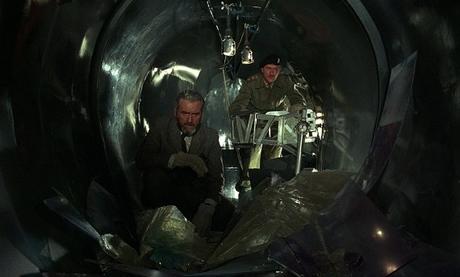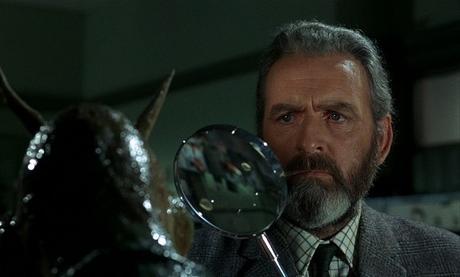
Once upon a time it was quite common to see movies either inspiring TV shows or leading to direct spin-offs. This still happens of course but it doesn't seem to take place with the same frequency. On the other hand, we've now grown accustomed to seeing TV shows being adapted or reimagined as big screen vehicles, with variable success. In fact, you might be forgiven for thinking the latter is a purely modern phenomenon. But it's not really, it had been going on long ago and one of the studios that became aware early on of the potential for commercial exploitation was Hammer in the UK. Nigel Kneale's Quatermass serials were big hits for the BBC and Hammer seized the opportunity to turn them into cinema features, significantly boosting their fortunes and profile in the process. That was in the 50s, and Hammer would return to this winning formula again in the following decade when Quatermass and the Pit (1967) stylishly revived the series in color.
The ominous-sounding pit of the title is an excavation taking place at a London underground station, Hobbs End, aimed at extending the line. This is our point of entry, following the workmen as they shovel out the clay. In the midst of this routine labor something irregular is spotted trundling along the conveyor belt - the remains of a skull. Almost immediately, another section of earth is pulled away to reveal an almost complete skeleton. So one excavation gives way to another, the structural yielding to the archaeological, this one under the supervision of Dr Roney (James Donald). However, the relatively standard prehistoric material being retrieved isn't all that's been buried at this site, the unexpected discovery of an unfamiliar casing suggests there might be an explosive device keeping the ancient residents company. And it's here that Bernard Quatermass (Andrew Keir), professor of physics and head of the government's rocket research, comes into the picture. Furthermore, this is also the stage at which the film shifts from the realm of the mundane towards that of the fantastic, and potentially horrific. Quatermass, Roney, and Roney's assistant Barbara Judd (Barbara Shelley), find themselves gradually drawn to the conclusion that the contents of Hobbs End station may not be from this planet at all. If their theories are correct, they may have stumbled upon that long sought after "missing link" in the evolutionary chain, something which promises to be not only startling in its audacity but also terrifying in potency and destructiveness.

I've never seen the original TV serial that formed the basis for this adaptation but I've heard that it was a triumph, a high point for the medium. I've also seen claims that the film, while very good, didn't quite measure up to its origins. I do intend to fill in this gap in my viewing knowledge at some point but for now all I can do is comment on the movie as I see it. I think I first saw this at some time back in the 1980s and it made an instant impression. Anyone familiar with Hammer films will know what I mean when I say that they had a "feel" to them which was unmistakable. This was partly due to the casting but, as with films like Quatermass and the Pit, it was still apparent even if many of the faces weren't as familiar. It was as much the contribution of the team behind the cameras that created that unique Hammer vibe as anything. Just seeing credits which promised production by Anthony Nelson Keys, photography by Arthur Grant, art direction by Bernard Robinson etc meant you were in for a cinematic experience that had Hammer stamped all over it.
Roy Ward Baker had enjoyed success in Hollywood, UK cinema and then worked quite extensively in British TV before coming to Hammer. As such, his was a sure hand directing and he obviously slotted neatly into the team as he went on to take charge of a number of features for the studio. Possibly as a result of being a serial in the first place the script, having presumably been compressed to some extent, moves along at a reasonable pace, taking its time only where necessary, and there's no shortage of incident to hold the attention. Sci-Fi generally depends on intelligent writing and, perhaps more so in recent times, visual effects to be considered successful. While I don't believe effects are the be all and end all in any production, it's clear that they do play a part in the enjoyment of many - in Quatermass and the Pit this aspect ought to be considered perfectly satisfactory although obviously not of the kind audiences today would be used to. Of greater importance is the quality of the writing and again, without wishing to go into too much detail and thus spoiling the film for anyone who hasn't seen it, I believe Kneale's script fulfills the basic requirement of any good piece of science fiction: it asks as many questions as it answers and encourages the viewer to think.

Kneale never made any secret of the fact he disapproved (to say the least) of the decision to cast US actor Brian Donlevy as Quatermass in the first two adaptations of his work, The Quatermass Xperiment and Quatermass II, something I've seen fans complain about too. Frankly, I never had any problem with Donlevy and quite liked the energy and assertiveness he brought to his interpretation, although I can understand too how a writer might feel displeased with a characterization he found too far removed from his own vision. Anyway, Andrew Keir tackles the role of Quatermass in a different way, emphasizing the more thoughtful sides of the man but retaining something of an edge at the same time. That tougher, more stubborn streak emerges most noticeably when he's confronting the supercilious and dismissive Colonel Breen whose military inflexibility is captured neatly by Julian Glover. James Donald has a certain reserve and remoteness as Roney, lacking some of the warmth and companionable charm of Keir, but that's something which serves his character well, bearing in mind how he's seen to develop in the latter stages of the film in particular. Barbara Shelley feels like one of the constants of British TV and cinema. She appeared in a huge number of notable productions, and something like a half dozen or so Hammer films among them. The roles offered to women in Sci-Fi weren't always the most interesting yet Shelley's part in Quatermass and the Pit is actually quite pivotal and she comes across as playing an important part in the central team.
Some Hammer films have been difficult to come by and really only became readily available in recent years. However, that was never the situation with Quatermass and the Pit, it being one of those titles that never seemed to be out of print for any length of time. I had the DVD for years and then picked up the UK Blu-ray last year as I reckoned it was the kind of movie that might benefit from the upgrade, and it does. The old DVD was perfectly acceptable to my eyes but the Hi-Def version brings out the details and colors even more and gives the whole thing an attractive punch. The film remains an absorbing one no matter how it's viewed of course - it's up there among the very best Hammer productions and it's also one of the finest British Sci-Fi movies.
